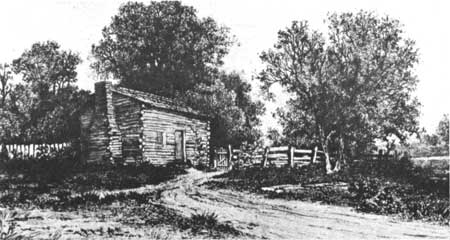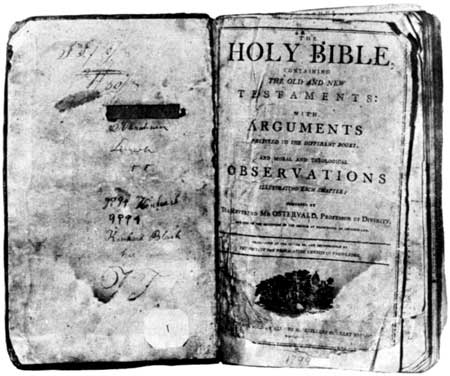|
FORD'S THEATRE National Historic Site |
 |
Lincoln's Life as Depicted in the Museum
Exhibits (continued)

An artist's conception of the Lincoln birth
cabin.
(Reproduced from a sketch in the Lincoln Museum
Collection.)
BIRTH AND EARLY LIFE OF LINCOLN. Abraham Lincoln was born in a log cabin at the "Sinking Spring" farm, near Hodgenville, Ky., on February 12, 1809. When Abraham was 2 years old, his father, Thomas Lincoln, moved the family to a farm at Knob Creek, 10 miles north of the birthplace. In the autumn of 1815, Lincoln and his sister Sarah were sent for short periods to the school of Zachariah Riney, located 2 miles from the Knob Creek home. One hundred years after the departure of the Lincoln family from the Hodgenville farm, the traditional birth cabin was enshrined in a marble memorial at the "Sinking Spring" farm.

The frontispiece of the Bible of Thomas Lincoln,
the father of Abraham Lincoln.
(Reproduced from the original in
the Abraham Lincoln Birthplace National Historic Site, Hodgenville,
Ky.)
The Lincoln family Bible, now at the Abraham Lincoln Birthplace National Historic Site, Hodgenville, Ky., was for many years in the Lincoln Museum collection. This is the Bible used by Lincoln's mother, Nancy Hanks Lincoln, in reading to him and the other Lincoln children. Inside the cover the name of Abraham Lincoln appears in a youthful hand. In 1893, it was sold by the Johnstons, stepchildren of Thomas Lincoln, for exhibition at the Chicago World's Fair. Later it was acquired for the Oldroyd collection.
In 1816, the Lincoln family ferried the Ohio River and settled on a farm near Gentryville, Ind. Here young Lincoln worked on a farm for 25 cents a day. In 1827 he was hired to run a ferry across the Ohio River at the mouth of Anderson's Creek. In 1828, Lincoln helped to take a boatload of produce to New Orleans. On a second trip in 1831, Lincoln viewed the slave market there. His sentiments against the enslavement of human beings are said to have originated with this visit.
On the trip to New Orleans in 1831, the flatboat stuck on the mill dam at New Salem, Ill. The boat was unloaded, shoved over the dam, and the journey resumed, Reflecting upon this experience, and a later one in which a steamboat on which he had taken passage ran aground, he devised a scheme for lightening grounded vessels by inflating air chambers near the water line. A model embodying the idea was whittled out in his law office, and on May 22, 1849, a patent was granted for the device. A photograph of the model and a copy of Lincoln's application for the patent may be seen in the Museum.
The inventive capacity of Lincoln is also shown in the model of a wagon which he made in 1840. The front wheels of the wagon turn instead of the axle, employing the same principle as the modern automobile. No parent was ever issued for the model which was acquired by Oldroyd for his collection.

|

| History | Links to the Past | National Park Service | Search | Contact |
|
Last Modified: Mon, Dec 2 2002 10:00:00 am PDT |

